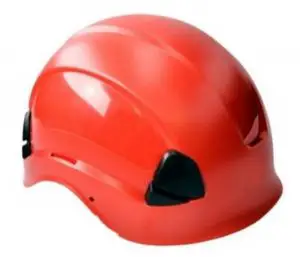If you’re like most people, you probably think that climbing helmets are made of some kind of high-tech, space-age material. But the truth is, they’re actually made of a lot of different things. Keep reading to find out more.
What are climbing helmets made of?
Most climbing helmets are made of polystyrene foam covered with a tough outer shell. The shell helps to protect the foam from UV light and abrasion. Some helmets have a ventilation system to help keep your head cool.
There are three different types of materials that climbing helmets are commonly made from polystyrene, ABS plastic, and carbon fiber. Each type of material has its own unique set of benefits and drawbacks:
- Polystyrene is the lightest and cheapest type of material used in helmets. It is also the least durable, meaning that it is more likely to crack or shatter in a fall. However, polystyrene helmets are still highly effective at protecting your head from impact injuries.
- ABS plastic is a bit heavier and more expensive than polystyrene, but it is also more durable. This makes ABS plastic helmets a good choice for climbers who want a bit more protection without sacrificing too much weight.
- Carbon fiber is the strongest and most expensive type of material used in helmets. Carbon fiber helmets are incredibly lightweight and provide the best protection against impact injuries. However, they can be difficult to find in stores and may not fit as snugly as other types of helmets.
How do climbing helmets work?
Climbing helmets are designed to protect your head from falling debris and to cushion your head in the event of a fall. They are not designed to protect your head from being hit by a large rock or another object. In order to be effective, a climbing helmet must fit snugly and not impede your vision.
They are usually constructed from a hardshell material, such as polycarbonate, that can withstand large impacts, and they often have a foam liner on the inside for added shock absorption.
Most helmets also have some ventilation to keep your head cool, and some even have features like rear-view mirrors and integrated headlights for extra safety in dark or low-light conditions. No matter what type of climbing you do, always wear a helmet to protect yourself from potential hazards.
The history of climbing helmets
Most early climbing helmets were made of leather, often with a metal band around the outside edge to reinforce it. The first known patent for a climbing helmet was issued in 1953 to an Italian company, but it wasn’t until the 1970s that modern plastic helmets began to appear on the market.
Today, most climbing helmets are made from expanded polystyrene foam (EPS) covered with a thin layer of hard-shell plastic. This construction is strong enough to protect your head from falling rocks and debris, but lightweight enough that you won’t get tired carrying it around all day.
How to choose the right climbing helmet
Climbing helmets are designed to protect your head from falls and debris while you’re climbing. They’re made of tough synthetic materials, like polycarbonate and polyurethane, that can withstand high impact.
When you’re shopping for a helmet, look for one that’s comfortable and fits well. It should also have an adjustable chin strap so you can get a snug, secure fit. And make sure the helmet you choose is rated for the type of climbing you’ll be doing.
If you’re just starting out, an all-purpose helmet that’s suitable for rock climbing, general mountaineering, and ice climbing will do the trick. But as you become more experienced, you may want to buy a specialized helmet for activities like caving or Boulder cricketing—a sport that involves scaling very tall boulders without ropes or other safety gear.
How to care for your climbing helmet
Once you’ve chosen the right helmet, you need to take care of it. Here are some tips:
- Store your helmet in a cool, dry place out of direct sunlight.
- Inspect your helmet before each use. Look for cracks, dents, or other damage. If you find any, retire the helmet and replace it with a new one.
- Don’t use paint, adhesives, or other chemicals on your helmet. These can weaken the materials and make the helmet less effective in a fall.
The benefits of wearing a climbing helmet
Whether you’re a beginner or a seasoned veteran, wearing a climbing helmet is always a good idea. They can help prevent head injuries that could potentially be fatal. So next time you hit the rock wall or go for a hike, be sure to strap on your helmet!
Climbing helmets are designed to protect your head from falling debris, rockfall, and impact in the event of a fall. They are made of durable materials that can withstand hard impacts and protect your head from serious injury.
Most climbing helmets are made of tough plastic shells with foam linings that absorb impact. Some higher-end models also have features like adjustable vents and Bengaline webbing that improve comfort and fit.
The importance of wearing a climbing helmet
Climbing helmets are an essential piece of safety equipment for climbers of all abilities. They are designed to protect your head from impacts with rocks, falls, and other hazards.
Most climbing helmets on the market today are made from a combination of different materials, depending on the manufacturer. The most common materials used in climbing helmet construction are polycarbonate, ABS plastic, and expanded polystyrene (EPS). These materials are designed to help protect the head of the helmet wearer from potential injuries.
In Closing
Climbing helmets can be made of various materials, each with unique strengths and weaknesses. Regardless of what your climbing helmet is made of, the most important thing to do is to wear it.
NEXT UP: What Jobs Require a Balaclava?

